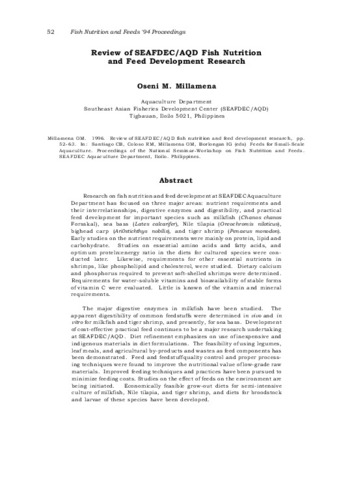Food consumption of seaperch, Lates calcarifer, in captivity.
| dc.contributor.author | Avila, E.M. | |
| dc.contributor.editor | Huisman, E. A. | |
| dc.contributor.editor | Zonneveld, N. | |
| dc.contributor.editor | Bouwmans, A. H. M. | |
| dc.date.accessioned | 2011-06-22T09:35:14Z | |
| dc.date.available | 2011-06-22T09:35:14Z | |
| dc.date.issued | 1989 | |
| dc.identifier.uri | http://hdl.handle.net/10862/311 | |
| dc.description.abstract | In the Philppines, feeds and constitutes some 70% of the total capital cost in aquacultural, which illustrates the central ipmortance of such inputs and at the same time justifies a major research effort to study the field of nutrition, feeds, and feeding. Given a nutritionally adecquate food, it is necessary to examine whether environmental condition (e.g., water temperature, oxygen , etc.) allow fish to efficiently use the food for growth to ensure a profitable yield. If yioeld is as central to aquaculture as growth is to fish, then the improvement of fish yield in aquaculture should benefit from the fundamental understanding of environmental control of fish growth. In tropical aquaculture where high temperature are the outstanding characteristics, it is worth consideriing whether such temperatures favor efficient fish production. Since temperature increases the rate o metabolic processess in fish, the energetic cost of this elevated metabolic activity may be considered in competition with growth for a share of the energy derived from the food (Brett, 1979). These interacting factors of food (intake and ration) and temperature and their effects on fish growth should be thoroughly studied if an economicaly vaible management is desired. The present research project focussed on research (Lates calcarofer) aquaculture by using the bio-energetic concept following the models of weel studied species such as perch, Perca fluviatilis (Solomon & Brafield, 1972); sockeye salmon, Oncorhynchus nerka (Brett, 1979); brown trout, salmo trutta (Elliott, 1972; 1975a; 1975b; 1976; 1982), and the African catfish, clarias gariepinus (Hogendoorn, 1983; Machiels & Henken, 1986). This, being a long term goal connat be attained before basic variables will have been studied. The immediate aims of this research project era, therefore, (1) examination of feeding rates and food consumption of the seaperch in relation to body size and temperature, and (2) determination of growth rate in relation to temperature and ration size. This study will be conducted over a 3-years period. Firstly preliminary trials on feeding rates and food consumption by individual seaperch will be carried out to determine minimumand maximum rations. Subsequently experiments studying the relation between temperature, ration (starvation, maximum, minimum) and growth will be conducted. Variables and parameters to be investigated durig the experiment will concentrate on body size, body composition, composition of growth increment,tempereture and metabolism (oxygen consumption). | en |
| dc.language.iso | en | en |
| dc.publisher | Pudoc | en |
| dc.relation.ispartof | In: Huisman, E.A., Zonneveld, N., Bouwmans, A.H.M. (eds.). Aquaculture Research in Asia: Management Techniques and Nutrition. Proceedings of the Asian Seminar on Aquaculture Organized by IFS, 14-18 November 1988, Malang, Indonesia. Wageningen: Pudoc. pp. 57-61 | en |
| dc.subject | Philippines | en |
| dc.subject | sea bass | en |
| dc.subject | Lates calcarifer | en |
| dc.subject.lcc | VF SP 102 | |
| dc.title | Food consumption of seaperch, Lates calcarifer, in captivity. | en |
| dc.type | Conference paper | en |
| dc.citation.spage | 57 | |
| dc.citation.epage | 61 | |
| dc.citation.conferenceTitle | Aquaculture Research in Asia: Management Techniques and Nutrition. Proceedings of the Asian Seminar on Aquaculture Organized by IFS, 14-18 November 1988, Malang, Indonesia | en |
| dc.subject.asfa | food fish | en |
| dc.subject.asfa | food consumption | en |
| dc.subject.scientificName | Lates calcarifer | en |
Files in this item
| Files | Size | Format | View |
|---|---|---|---|
|
There are no files associated with this item. |
|||
This item appears in the following Collection(s)
-
Conference Proceedings [300]


